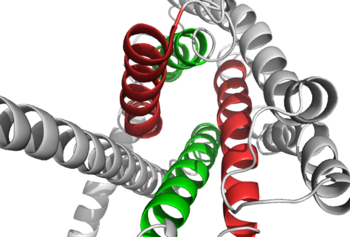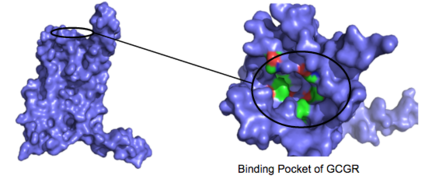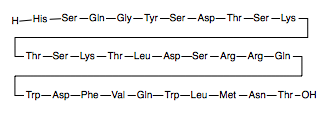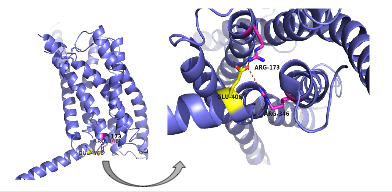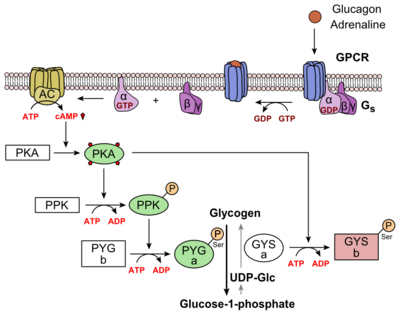Sandbox Reserved 1165
From Proteopedia
(Difference between revisions)
| Line 44: | Line 44: | ||
=Clinical Relevancy= | =Clinical Relevancy= | ||
| - | Of the fifteen human class B GPCRs, eight have been | + | Of the fifteen human class B GPCRs, eight have been confirmed as potential [https://en.wikipedia.org/wiki/Biological_target drug target]. <ref name="Drug">PMID: 24628305</ref> [http://www.wisegeek.com/what-are-therapeutic-agents.htm Therapeutic agents] have been created from the GCGR peptides. Overall, family B GPCRS have been difficult drug targets. This difficulty is partially related to the inherent flexibility in the class B GCGR 7TM. The flexibility comes from the conserved hydrogen bonds that flank a glycine residue, and this structure along with the ECD and its role of interactions on the extracellular side of receptors may provide evidence to how class B receptors adjust its conformational spectra for various receptors. Researchers hope to show how these conformations can be utilized in potential treatments of a wide array [https://en.wikipedia.org/wiki/List_of_mental_disorders disorders]. <ref name="Drug">PMID: 24628305</ref> |
==Potential Inhibitors== | ==Potential Inhibitors== | ||
Research for class B GCGR [https://en.wikipedia.org/wiki/Enzyme_inhibitor inhibitors] is primarily looking into [https://en.wikipedia.org/wiki/Allosteric_regulation allosteric inhibitors] having the ability to target specific receptors in order to treat problems like [https://en.wikipedia.org/wiki/Stress-related_disorders stress disorders], managing [http://www.webmd.com/diabetes/guide/diabetes-hyperglycemia hyperglycemia], and also alternative mechanisms for treating [https://en.wikipedia.org/wiki/Migraine migraines]. <ref name="Inhibitors">PMID: 24189067</ref> Known inhibitors include [https://en.wikipedia.org/wiki/Monoclonal_antibody monoclonal antibodies] which inhibit glucagon receptors through an allosteric mechanism. The monoclonal antibodies bind to two different sites, the ECD opposite of the binding region and then the helical portion of the ECD as well. <ref name="Last">PMID: 19305799</ref> | Research for class B GCGR [https://en.wikipedia.org/wiki/Enzyme_inhibitor inhibitors] is primarily looking into [https://en.wikipedia.org/wiki/Allosteric_regulation allosteric inhibitors] having the ability to target specific receptors in order to treat problems like [https://en.wikipedia.org/wiki/Stress-related_disorders stress disorders], managing [http://www.webmd.com/diabetes/guide/diabetes-hyperglycemia hyperglycemia], and also alternative mechanisms for treating [https://en.wikipedia.org/wiki/Migraine migraines]. <ref name="Inhibitors">PMID: 24189067</ref> Known inhibitors include [https://en.wikipedia.org/wiki/Monoclonal_antibody monoclonal antibodies] which inhibit glucagon receptors through an allosteric mechanism. The monoclonal antibodies bind to two different sites, the ECD opposite of the binding region and then the helical portion of the ECD as well. <ref name="Last">PMID: 19305799</ref> | ||
Revision as of 02:49, 19 April 2016
References
- ↑ 1.0 1.1 Hollenstein K, de Graaf C, Bortolato A, Wang MW, Marshall FH, Stevens RC. Insights into the structure of class B GPCRs. Trends Pharmacol Sci. 2014 Jan;35(1):12-22. doi: 10.1016/j.tips.2013.11.001. Epub, 2013 Dec 18. PMID:24359917 doi:http://dx.doi.org/10.1016/j.tips.2013.11.001
- ↑ 2.0 2.1 2.2 2.3 2.4 2.5 2.6 Siu FY, He M, de Graaf C, Han GW, Yang D, Zhang Z, Zhou C, Xu Q, Wacker D, Joseph JS, Liu W, Lau J, Cherezov V, Katritch V, Wang MW, Stevens RC. Structure of the human glucagon class B G-protein-coupled receptor. Nature. 2013 Jul 25;499(7459):444-9. doi: 10.1038/nature12393. Epub 2013 Jul 17. PMID:23863937 doi:10.1038/nature12393
- ↑ 3.0 3.1 3.2 3.3 3.4 Miller LJ, Dong M, Harikumar KG. Ligand binding and activation of the secretin receptor, a prototypic family B G protein-coupled receptor. Br J Pharmacol. 2012 May;166(1):18-26. doi: 10.1111/j.1476-5381.2011.01463.x. PMID:21542831 doi:http://dx.doi.org/10.1111/j.1476-5381.2011.01463.x
- ↑ Thomsen J, Kristiansen K, Brunfeldt K, Sundby F. The amino acid sequence of human glucagon. FEBS Lett. 1972 Apr 1;21(3):315-319. PMID:11946536
- ↑ 5.0 5.1 Bortolato A, Dore AS, Hollenstein K, Tehan BG, Mason JS, Marshall FH. Structure of Class B GPCRs: new horizons for drug discovery. Br J Pharmacol. 2014 Jul;171(13):3132-45. doi: 10.1111/bph.12689. PMID:24628305 doi:http://dx.doi.org/10.1111/bph.12689
- ↑ Mukund S, Shang Y, Clarke HJ, Madjidi A, Corn JE, Kates L, Kolumam G, Chiang V, Luis E, Murray J, Zhang Y, Hotzel I, Koth CM, Allan BB. Inhibitory mechanism of an allosteric antibody targeting the glucagon receptor. J Biol Chem. 2013 Nov 4. PMID:24189067 doi:http://dx.doi.org/10.1074/jbc.M113.496984
- ↑ Hoare SR. Allosteric modulators of class B G-protein-coupled receptors. Curr Neuropharmacol. 2007 Sep;5(3):168-79. doi: 10.2174/157015907781695928. PMID:19305799 doi:http://dx.doi.org/10.2174/157015907781695928
- ↑ 8.0 8.1 8.2 Yang L, Yang D, de Graaf C, Moeller A, West GM, Dharmarajan V, Wang C, Siu FY, Song G, Reedtz-Runge S, Pascal BD, Wu B, Potter CS, Zhou H, Griffin PR, Carragher B, Yang H, Wang MW, Stevens RC, Jiang H. Conformational states of the full-length glucagon receptor. Nat Commun. 2015 Jul 31;6:7859. doi: 10.1038/ncomms8859. PMID:26227798 doi:http://dx.doi.org/10.1038/ncomms8859
